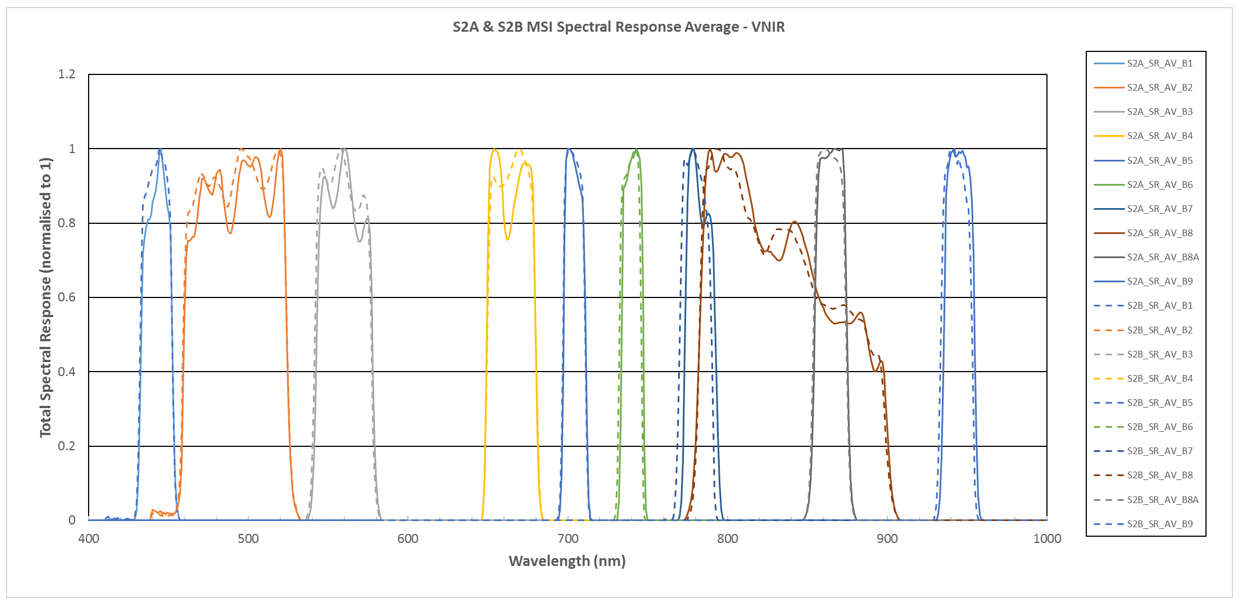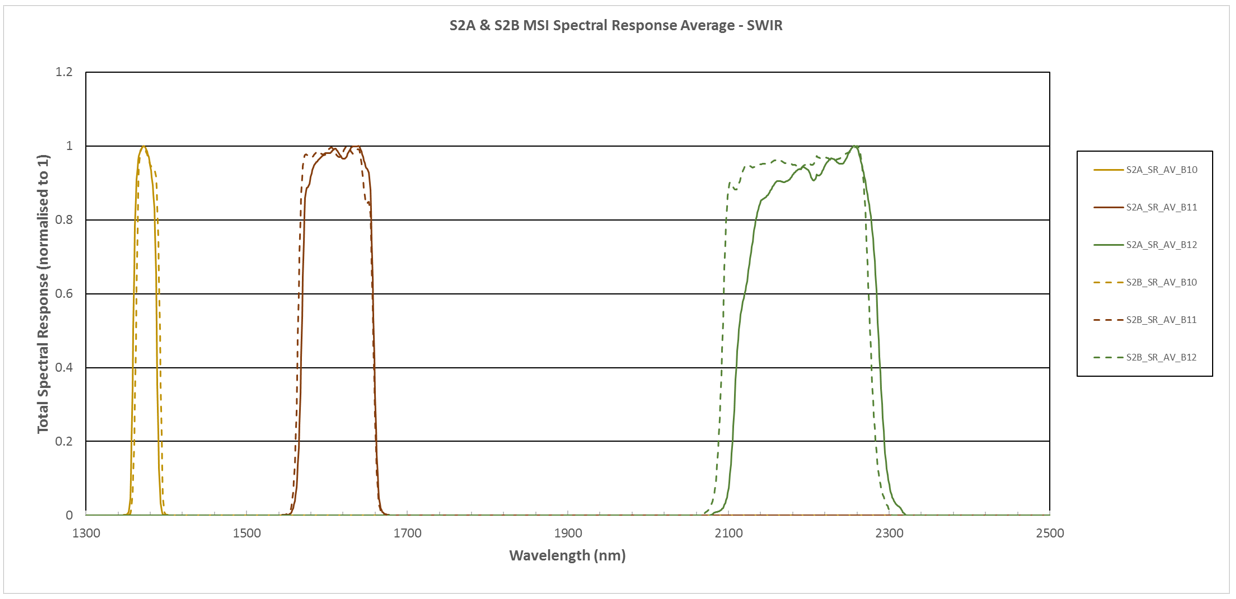SENTINEL-2 products respect stringent radiometric and geometric image quality requirements. For further information, please refer to the Sentinel-2 Annual Performance Report – Year 2022.
Radiometric Performance
The following table shows the spectral band characteristics and the MSI specified performance (radiance sensibility range and SNR).
| Band number | Spatial Sample Distance (m) | Central wavelength (nm) | Bandwidth (nm) | Radiance sensibility range Lmin < Lref < Lmax (W.m-2.sr-1.µm-1) |
SNR Specification (at Lref) | |
| 1 | 60 | 443 | 20 | 16 < 129 < 588 | 129 | |
| 2 | 10 | 490 | 65 | 11.5 < 128 < 615.5 | 154 | |
| 3 | 10 | 560 | 35 | 6.5 < 128 < 559 | 168 | |
| 4 | 10 | 665 | 30 | 3.5 < 108 < 484 | 142 | |
| 5 | 20 | 705 | 15 | 2.5 < 74.5 < 449.5 | 117 | |
| 6 | 20 | 740 | 15 | 2 < 68 < 413 | 89 | |
| 7 | 20 | 783 | 20 | 1.5 < 67 < 387 | 105 | |
| 8 | 10 | 842 | 115 | 1 < 103 < 308 | 174 | |
| 8a | 20 | 865 | 20 | 1 < 52.5 < 308 | 72 | |
| 9 | 60 | 945 | 20 | 0.5 < 9 < 233 | 114 | |
| 10 | 60 | 1 375 | 30 | 0.05 < 6 < 45 | 50 | |
| 11 | 20 | 1 610 | 90 | 0.5 < 4 < 70 | 100 | |
| 12 | 20 | 2 190 | 180 | 0.1 < 1.5 < 24.5 | 100 | |

Figure 1: Spectral Response for the SENTINEL-2 VNIR Bands

Figure 2: Spectral Response for the SENTINEL-2 SWIR Bands
The Level-1 radiometry quality requirements are:
- Absolute radiometric uncertainty: the absolute radiometric uncertainty shall be better than 5% (goal 3%).
- Inter-band relative radiometric uncertainty: 3%.
- Multi-temporal relative radiometric uncertainty: 1%.
- Linearity knowledge accuracy: 1%.
- Channel-to-channel cross-talk: <0.5%.
- Modulation Transfer Function (MTF): 0.15 to 0.3 (for 10 m bands) and < 0.45 (for 20 m and 60 m bands).
The objective of absolute radiometric accuracy is 3%. To guarantee this high quality radiometric performance, a full-field and full-pupil on-board diffuser is employed.
The knowledge of the band equivalent wavelength is also very important because an error of 1 nm induces errors of several per cent on the reflectance value, especially in the blue part and in the near-infra-red part of the spectrum.
The equivalent wavelength is known with an uncertainty below 1 nm. In the same way, an error on the absolute calibration measurement affects the physical value accuracy. For this sensor, the inter-band calibration accuracy is 3% and the multi-temporal calibration is 1%. Moreover, the non-linearity of the instrument response has accuracy better than 1% and the channel-to-channel cross-talk is less than 0.5%.
The image quality is due to the system MTF, which is between 0.15 and 0.3 at the Nyquist frequency for spectral bands with 10 m and 20 m spatial resolution and lower than 0.45 for spectral bands with 60 m spatial resolution.
More information on both the SENTINEL-2A and SENTINEL-2B Spectral Responses can be found here.
Geometric Performance
The Level-1 geometric quality requirements are:
- A priori absolute geo-location uncertainty (before performing any processing): 2 km 3σ
- Absolute geolocation uncertainty: 20 m 2σ without GCPs and 12.5 m 2σ with GCPs
- Multi-temporal registration: The spatial co-registration accuracy of Level 1C data acquired at different dates over the same geographical area shall be better than or equal to 0.3 pixels at 2 σ confidence level.
- Multi-spectral registration (for any two spectral bands): the inter-channel spatial co-registration of any two spectral bands shall be better than 0.30 of the coarser achieved spatial sampling distance of these two bands at 3σ confidence level.
All of these performance requirements for operational products will are and validated by processes and algorithms on-board and on-ground corresponding to calibration and validation (cal/val) activities which are the responsibility of the SENTINEL-2 Optical Mission Performance Cluster (OPT-MPC).